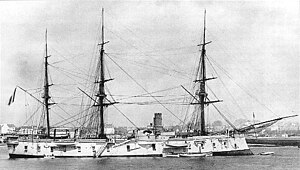French ironclad La Galissonnière

La Galissonnière in 1885
|
|
| History | |
|---|---|
|
|
|
| Name: | La Galissonnière |
| Namesake: | Roland-Michel Barrin de La Galissonière |
| Builder: | Brest |
| Laid down: | 22 June 1868 |
| Launched: | 7 May 1872 |
| Commissioned: | 18 July 1874 |
| Fate: | Condemned 24 December 1894 |
| General characteristics | |
| Class and type: | La Galissonnière-class ironclad |
| Displacement: | 4,654 metric tons (4,580 long tons) |
| Length: | 76.62 m (251 ft 5 in) |
| Beam: | 14.84 m (48 ft 8 in) |
| Draft: | 6.55 m (21.5 ft) (mean) |
| Installed power: | |
| Propulsion: | 2 shafts, 2 Vertical compound steam engines |
| Sail plan: | Ship rig |
| Speed: | 12 knots (22 km/h; 14 mph) |
| Range: | 2,920 nautical miles (5,410 km; 3,360 mi) at 10 knots (19 km/h; 12 mph) |
| Complement: | 352–382 |
| Armament: |
|
| Armor: | |
La Galissonnière was lead ship of a class of wooden-hulled, armored corvettes built for the French Navy during the 1870s. She was named after the victor of the Battle of Minorca in 1756, Marquis de la Galissonnière. She bombarded Sfax in 1881 as part of the French occupation of Tunisia and was present in Alexandria shortly before the British bombarded it before the beginning of the 1882 Anglo-Egyptian War. The ship participated in a number of battles during the Sino-French War of 1884–85. La Galissonnière was condemned in 1894.
The La Galissonnière-class ironclads were designed as faster, more heavily armed versions of the Alma-class armored corvettes by Henri Dupuy de Lôme. They used the same central battery layout as their predecessors, although the battery was lengthened 4 meters (13 ft 1 in) to provide enough room to work the larger 240-millimeter (9.4 in) guns. A two-propeller layout was adopted in an unsuccessful attempt to reduce the ship's draft.
La Galissonnière measured 76.62 meters (251 ft 5 in) between perpendiculars, with a beam of 14.84 meters (48 ft 8 in). She had a mean draft of 6.55 meters (21 ft 6 in) and displaced 4,654 metric tons (4,580 long tons). The ship had a metacentric height of .926 meters (3 ft 0.5 in). Her crew numbered between 352 and 382 officers and men.
...
Wikipedia
